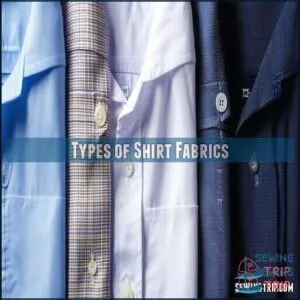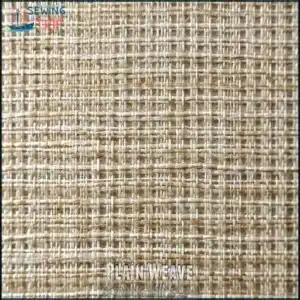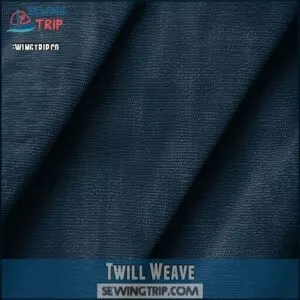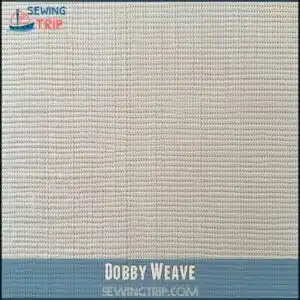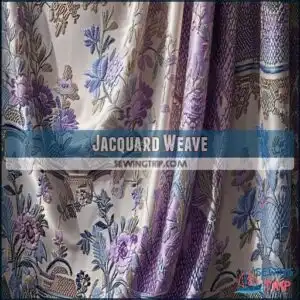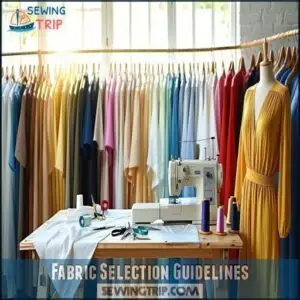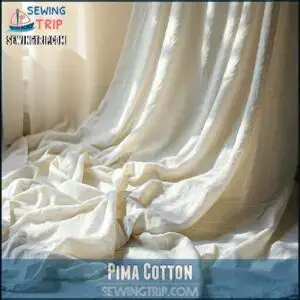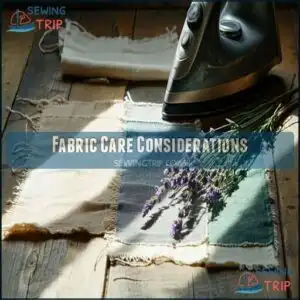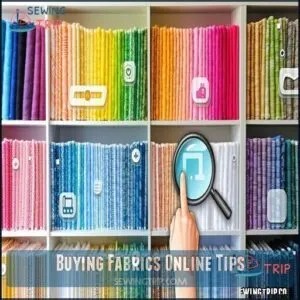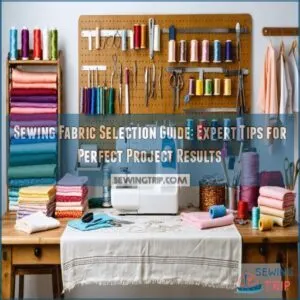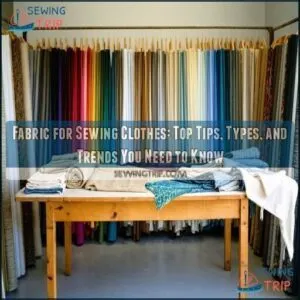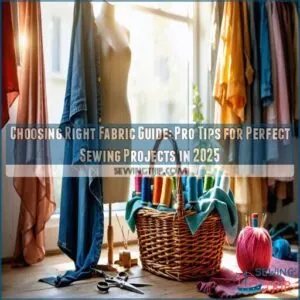This site is supported by our readers. We may earn a commission, at no cost to you, if you purchase through links.
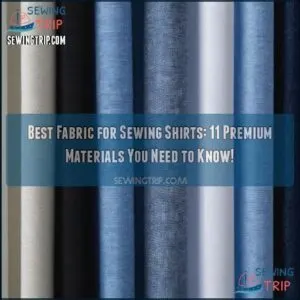 When picking the best fabric for sewing shirts, think about comfort, style, and durability.
When picking the best fabric for sewing shirts, think about comfort, style, and durability.
Fine cotton, like Pima or Egyptian, is a top choice—it’s soft, breathable, and easy to sew, making it perfect for casual or dress shirts.
For a lightweight summer feel, linen offers unmatched breeziness, while silk adds a touch of elegance to formal designs.
If you need something durable yet stylish, fabrics like Oxford or twill balance structure with texture.
The weave, weight, and thread count matter too, so choose wisely based on the occasion or season.
There’s more to fabric selection than meets the eye, considering factors like durability to ensure the best choice for your needs.
Table Of Contents
Key Takeaways
- Pick fine cotton like Pima or Egyptian for unmatched softness, breathability, and durability in shirts.
- Choose linen for lightweight , breathable summer shirts, though its natural wrinkles add charm.
- Look for fabrics like poplin, twill, or Oxford for tailored styles; twill offers durability, and Oxford resists wrinkling.
- Pay attention to thread count, weave, and GSM to balance comfort, style, and longevity in your shirt fabrics.
Choosing Best Shirt Fabrics
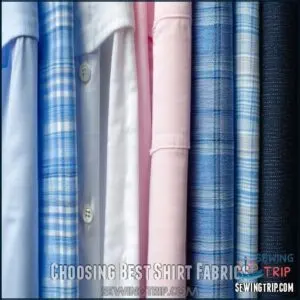
You’ll find that selecting the right fabric determines both the comfort and longevity of your handmade shirts.
Your choice among premium materials like fine cotton, silk, or linen will substantially impact how your finished garment looks, feels, and performs during daily wear, with comfort and longevity being key considerations.
Fine Cotton
Every serious shirt maker knows that fine cotton represents the pinnacle of shirting fabrics.
Fine cotton is the ultimate fabric for shirts—soft, breathable, and durable, offering unmatched comfort and timeless elegance.
Made from premium cotton with exceptional staple length, it offers unmatched quality for your sewing projects.
Five reasons fine cotton elevates your shirts:
- Incredibly smooth texture that feels luxurious against skin
- Superior durability factors that withstand regular washing
- Natural breathability that keeps you comfortable all day
- Higher cotton grades guarantee consistent fabric softness
- Ethical sourcing options available from premium suppliers
The use of premium suppliers ensures that the cotton is not only of high quality but also sourced responsibly.
Cotton
While fine cotton offers luxurious quality, standard cotton remains the workhorse of shirt fabrics.
You’ll find cotton types ranging from everyday cotton poplin to sturdy cotton twill, all offering excellent breathability and comfort.
Cotton blends add performance features while maintaining that natural feel.
Organic cotton provides an eco-friendly option without sacrificing durability.
Cotton weaves vary in texture and weight, making this easy to sew fabric perfect for beginners and experienced sewists alike.
Silk
Silk shirt fabric is a classic choice, offering elegance and comfort. Made through intricate silk production, it’s prized for softness and luxurious drape.
Sewing with silk can be tricky, but the results are worth it.
- Benefits: Lightweight and hypoallergenic.
- Drawbacks: High silk cost, delicate care.
- Options: Silk blends for durability.
- Silk alternatives: Budget-friendly choices.
Linen
While silk offers luxury, linen brings you timeless durability with a distinctly textured look.
Made from flax plant fibers, linen fabric for sewing shirts provides exceptional breathability that keeps you cool on hot days.
Though it wrinkles easily, this natural characteristic adds casual charm to your handmade garments.
Linen blends with cotton reduce creasing while maintaining that lightweight feel you’ll appreciate during summer months.
Fabric Properties Matter
You’ll need to understand thread count, GSM, and ply construction when selecting shirt fabrics since these properties directly impact comfort, durability, and overall quality.
A higher thread count typically means a smoother fabric, while the right GSM (grams per square meter) guarantees your shirt has the perfect weight for its intended use.
Thread Count
When selecting shirt fabrics, thread count serves as your fabric quality compass.
Higher counts typically indicate softer, smoother, and more luxurious materials.
- Ideal Count: Quality shirting starts at 60/2 and can reach 120/2 for premium fabrics
- Misleading Counts: Don’t be fooled by numbers alone—ply impact matters equally
- Count Durability: Fabrics over 100 thread count often feature two-ply construction for strength
- Luxury Fabrics: Fine Egyptian cotton boasts exceptional thread counts, creating unparalleled softness
GSM and Fabric Weight
While thread count tells you about fabric density, GSM reveals the complete weight story.
GSM (grams per square meter) measures how heavy your fabric is—a key factor when sewing shirts.
Lightweight fabrics (under 150 GSM) drape beautifully, while mediumweight options (150-350 GSM) offer more structure.
The ideal GSM impacts both comfort and performance, affecting how your shirt breathes and moves with you, which is crucial for comfort.
Two-Ply Construction
As fabric weight tells you about thickness, two-ply construction reveals how your shirt fabric is built for longevity.
When two yarns are twisted together instead of using a single thread, you’re getting a more resilient weave.
This construction method prevents pilling, improves durability, and creates a smoother finish.
Most quality fabrics with thread counts over 100 feature this technique, making your handmade shirts last substantially longer with increased longevity.
Types of Shirt Fabrics
You’ll find various shirt fabrics including poplin, twill, and oxford that each offer unique benefits for your sewing projects.
The fabric you select will determine your shirt’s durability, comfort, and overall appearance, so it’s important to understand the characteristics of each type, which will help in making an informed decision about the comfort of your shirt.
Poplin
Discover the crisp elegance of poplin, a smooth cotton fabric that’s perfect for professional dress shirts.
This lightweight material offers excellent breathability while maintaining a polished appearance.
- Features a plain weave with fine horizontal ribs that create a subtle texture
- Provides moderate durability despite its lightweight nature
- Drapes beautifully against the body without clinging
- Available in various cotton poplin variations at different price points
The key benefits of poplin, including its breathability, make it an ideal choice for those seeking comfort and style in their clothing.
Twill
While poplin offers elegance, twill brings character to your shirt-making arsenal.
Twill adds personality to shirts with its diagonal weave, blending durability, comfort, and a touch of character.
This distinctive fabric features a diagonal weave pattern that’s unmistakable once you know what to look for. Twill’s structure creates natural stretch and outstanding durability, making your shirts last longer than their plain-weave counterparts.
You’ll find numerous twill variations including denim twill for casual shirts and gabardine twill for more polished looks. For example, cavalry twill offers a sturdy and shiny option.
It’s a versatile choice that elevates any wardrobe.
Oxford
Many consider Oxford fabric the workhorse of shirt materials.
Its distinctive basket weave creates a textured surface that offers exceptional durability and wrinkle resistance.
You’ll appreciate how Oxford shirts maintain their shape throughout the day without crumpling.
This versatile cotton weave comes in various colors and Oxford blends, making it suitable for both casual outings and formal events.
Oxford styling typically features button-down collars for a classic look, and its durability is a key factor in its popularity.
Weave Patterns Explained
You’ll notice a dramatic difference in how your shirts look and feel based on their weave pattern.
The structure of how threads intersect creates unique textures and properties that determine everything from breathability to wrinkle resistance.
Plain Weave
Why does plain weave remain the foundation of shirt-making fabrics? This fundamental pattern creates a remarkably strong textile through its simple over-under construction.
The tight interlacing of threads produces a stable, versatile cloth ideal for shirts. The weave is sometimes referred to as tabby or linen weave.
Here’s what makes plain weave excellent for your projects:
- Forms a high-density structure with impressive durability
- Creates a smooth surface perfect for printing and dyeing
- Resists fraying better than other weaves, maintaining shape after washing
- Works exceptionally well for flat surfaces like shirt panels
Twill Weave
While plain weave gives you a straightforward grid pattern, twill weave creates distinctive diagonal lines that you’ll recognize instantly.
This popular weave passes weft yarns under and over several warp yarns in an alternating sequence, creating those characteristic ribs.
Twill’s structure makes it more pliable than plain weave, allowing it to drape beautifully over 3D features.
You’ll appreciate its strength and high density when sewing shirts that need both durability and comfort.
Other methods, such as dobby weave patterns, offer unique geometric textures.
Dobby Weave
Unlike twill’s diagonal patterns, dobby weave creates distinctive geometric designs through a special loom that raises and lowers warp threads individually.
This technique adds remarkable texture to shirt sewing fabric, making dobby shirt texture subtly sophisticated.
Dobby weave durability comes from its slightly raised surface, which resists wrinkles.
You’ll find dobby pattern variety from simple dots to intricate stripes, perfect for adding visual interest to shirtmaking fabrics without being overpowering.
Its unique construction allows for various textured designs.
Jacquard Weave
You’ll find jacquard weave creates intricate patterns with durability and texture, making it perfect for shirt sewing fabric, offering jacquard durability and unique jacquard patterns, with various jacquard applications.
These patterns are often achieved using specialized Jacquard looms, including formal apparel and home decor, at a relatively high jacquard cost.
The unique jacquard patterns make it suitable for different uses.
Fabric Selection Guidelines
Choosing the right fabric for your shirt starts with understanding how its properties match your needs.
Whether it’s for casual wear, formal occasions, or seasonal comfort, knowing what to look for guarantees your project turns out just right, which is crucial for casual wear.
Casual Shirts
When picking fabric for casual shirts, think comfort, durability, and style versatility.
Cotton shirt fabric is a go-to for its softness and ease of care. Linen shirt fabric works wonders in summer, offering a breathable, lightweight shirt fabric feel.
Blends like cotton-linen balance breathability and durability needs, while care requirements stay manageable for everyday wear.
For maximum comfort, consider fabrics with natural moisture-wicking properties that provide style versatility.
Formal Shirts
For dress shirts, fabrics like poplin, royal oxford, and broadcloth offer a polished look with smooth finishes.
Pairing these with classic formal shirt colors, such as white or light blue, guarantees versatility.
Consider Shirt Collar Styles and Cuff Style Options for added elegance.
Fabric Finish Options and Button Material Choices, like mother-of-pearl, elevate the sophistication of your formal wardrobe.
Seasonal Fabrics
When choosing seasonal fabrics, think about comfort and practicality.
Summer fabrics like linen and cotton are breathable and perfect for summer wear. Winter fabrics such as flannel and wool provide winter warmth.
For in-between seasons, spring blends and autumn textures balance comfort and style.
- Summer fabrics: Lightweight cotton, linen
- Winter fabrics: Flannel, wool
- All-weather options: Cotton-linen blends, chambray
Best Fabrics for Dress Shirts
In the context of dress shirts, choosing the right fabric is essential for both comfort and style.
High-quality options like Pima and Egyptian cotton offer softness, durability, and a polished finish perfect for formal wear.
Pima Cotton
Pima cotton stands out as one of the best shirt fabric types, offering unmatched softness and durability.
Known for its extra-long fibers, it creates a breathable shirt fabric perfect for all-day comfort.
Pima sourcing often guarantees higher quality, but its cost remains affordable compared to premium alternatives.
If you’re after the best shirt material, Pima delivers elegance and resilience effortlessly.
Egyptian Cotton
Egyptian cotton is the gold standard for luxury shirts, thanks to its extra-long fiber length. Giza cotton, a premium type, offers unmatched softness and durability.
Here’s why it’s worth the investment:
- Fabric Authenticity: Genuine Egyptian cotton guarantees quality.
- Shirt Cost: Higher but justified.
- Premium Fabrics: Perfect for dress shirts.
- Luxury Shirts: Feels exquisite.
Fabric Care Considerations
Caring for your shirt fabric properly guarantees it stays looking sharp and lasts longer.
From washing and ironing to knowing when dry cleaning is necessary, understanding fabric care is key to maintaining its quality.
Washing Instructions
Caring for premium shirt fabrics starts with proper fabric washing. Use cool water and gentle detergent to prevent shrinkage and preserve quality.
Always check care instructions for guidance. Separate light and dark colors to avoid bleeding.
For stubborn stains, treat them promptly. Skip fabric softeners on delicate materials, as they can weaken fibers.
Thoughtful clothing care guarantees lasting elegance. Use these tips to ensure your premium shirts remain in great condition, with proper fabric washing and gentle detergent being key to their longevity.
Ironing Tips
Ironing techniques can make or break your shirt fabric.
Always check the label for the right iron temperature. Use a protective cloth for delicate materials to avoid damage.
For wrinkle resistance, iron shirts slightly damp. Linen needs high heat, while cotton demands medium to high settings.
Keep your iron clean for stain removal and better fabric care.
Dry Cleaning
While ironing keeps shirts sharp, some fabrics demand gentler care.
Dry cleaning uses specialized solvents and stain removal techniques, perfect for delicate dress shirts or materials like silk. It extends garment lifespan but comes with cost considerations and an environmental impact.
Always check labels—proper fabric care guarantees your shirts stay crisp, stylish, and ready for any occasion, which is crucial for maintaining their quality and ensuring they remain sharp.
Sewing With Different Fabrics
Working with different fabric types for sewing shirts can feel like a mix of art and science.
Start by choosing the right needle—sharp needles work well for fine cotton, while heavier fabrics like twill or flannel need thicker ones.
Adjust your stitch settings based on the fabric weave; tighter stitches suit lightweight fabrics, while looser ones prevent puckering on thicker materials.
Seam finishes matter too—French seams add durability to delicate fabrics, while overlocking works for casual shirts.
Don’t forget pattern adjustments; slippery fabrics like silk may shift, so pin generously.
Fabric handling is key—prewash to avoid shrinkage and press seams for a polished look.
With care and precision, sewing any shirt fabric becomes a rewarding experience.
Buying Fabrics Online Tips
Shopping for fabrics online can save you time, but it requires careful attention to details like reviews and measurements.
Understanding fabric descriptions and weight guarantees you get the right material for your project, which is a complete concept to focus on when making a purchase.
Online Stores
Shopping for fabrics online? Stick to trusted online retailers like Amazon, Joanns, or Walmart for reliable fabric sources.
Many sites offer digital swatches and virtual consultations to guide your online fabric selection. Look for secure payments and detailed descriptions to avoid surprises.
Consider exploring various online options for a wider selection. Online fabric shopping saves time, but always double-check measurements and reviews before clicking “buy” to ensure a smooth purchase.
Fabric Reviews
Fabric reviews simplify fabric selection when sewing shirts.
Look for detailed insights, like:
- Durability Testing: Does the fabric withstand wear?
- Weave Comparison: Understand fabric texture and strength.
- Comfort Analysis: Lightweight or breathable for comfort?
- Value Assessment: Is quality worth the price?
Consider fiber composition too.
You can explore various fabric review shirts online.
Reliable reviews help you choose premium materials for durable, stylish shirts.
Measuring and Ordering
When buying fabric online, always check the fabric width, as it impacts how much yardage you’ll need.
Use online calculators to estimate yardage for your sewing project. Factor in fabric weights, too, since thicker fabrics may require adjustments.
Swatch requests help with fabric selection before committing. Be mindful of order minimums to avoid over-purchasing fabric for your shirt.
Accurate estimation requires a fabric width calculation to ensure you have enough material for your project, considering the order minimums.
Frequently Asked Questions (FAQs)
What is the best fabric for shirts?
For shirts, cotton poplin is your go-to—it’s silky, durable, and breathable.
Linen’s great for summer, while flannel shines in winter.
For premium options, pick Egyptian or Pima cotton for softness, luxury, and durability.
Which twill fabric is best for a shirt?
Cotton twill works best for shirts when you want durability, a soft texture, and a slightly heavier feel.
Its diagonal weave resists wrinkles, drapes well, and adds subtle elegance, making it practical for all-day wear.
What type of fabric do you use to make clothes?
When creating clothes, you balance form and function by using cotton for breathability, linen for summer coolness, or silk for luxurious elegance.
Match fabric choice to purpose, ensuring durability, comfort, and style seamlessly align.
What is the best fabric to sew with?
When sewing, pick fabrics that match your project.
Lightweight cotton is versatile and easy to work with. Linen breathes beautifully, while poplin and twill offer structure.
Always consider fabric drape, weight, and sewing ease.
What kind of fabric do you use for pants?
Choosing fabric for pants is like finding the perfect dance partner—it needs strength and flexibility.
Opt for denim, twill, or gabardine for durability, or linen and cotton blends for lightweight comfort in warmer weather.
What kind of fabric is best for a dress?
You’ll want a fabric that suits the dress style—lightweight chiffon or silk for elegance, breathable cotton or linen for casual wear, or stretchy jersey for comfort.
Consider the occasion, season, and desired silhouette.
What is the best fabric to sew a shirt?
Ever wondered why your shirt doesn’t feel right?
Go for cotton poplin—it’s lightweight, breathable, and versatile.
For summer, try linen; it’s airy but wrinkles.
Flannel shines in winter, adding warmth and cozy vibes.
Which type of fabric is best for a tshirt?
For t-shirts, cotton is your best bet—breathable, soft, and comfortable.
Blends like cotton-polyester add durability and stretch, while bamboo fabric offers eco-friendly softness.
Choose lightweight fabrics for everyday comfort and style versatility.
What is the best material to make a shirt out of?
Imagine wrapping yourself in a cloud—that’s the allure of fine cotton like Egyptian or Pima.
These breathable, durable fabrics are soft, luxurious, and versatile, making them perfect for crafting high-quality, comfortable shirts that are also very breathable.
What are luxury t-shirts made of?
Luxury T-shirts are often made from premium materials like Peruvian Pima cotton, Egyptian cotton, or Sea Island cotton.
These fabrics offer exceptional softness, durability, and breathability, while silk blends add a touch of elegance and drape.
Conclusion
Did you know cotton accounts for nearly 75% of shirt fabrics worldwide?
Choosing the best fabric for sewing shirts depends on your needs. Fine cotton like Pima or Egyptian works well for comfort and durability.
For lightweight summer options, linen shines, while silk offers elegance for formal wear.
Consider weave, thread count, and GSM for the right balance of style and practicality. With these tips, you’ll confidently pick fabrics that last and feel great to wear.
- https://en.wikipedia.org/wiki/Shirt
- https://www.encyclopedia.com/sports-and-everyday-life/fashion-and-clothing/textiles-and-weaving/textiles
- https://organiccottonplus.com/
- https://dexmat.com/blog/fabric-weave-patterns-for-textiles-and-composites/
- https://www.masterclass.com/articles/plain-weave-fabric-guide


